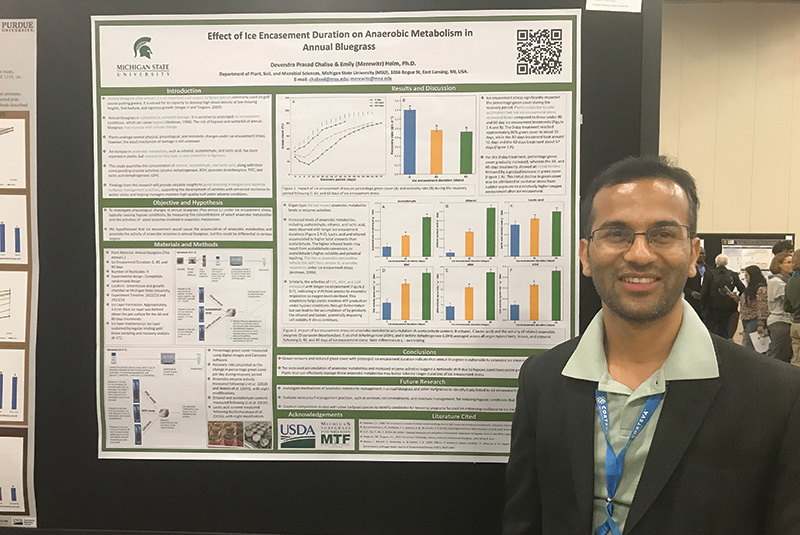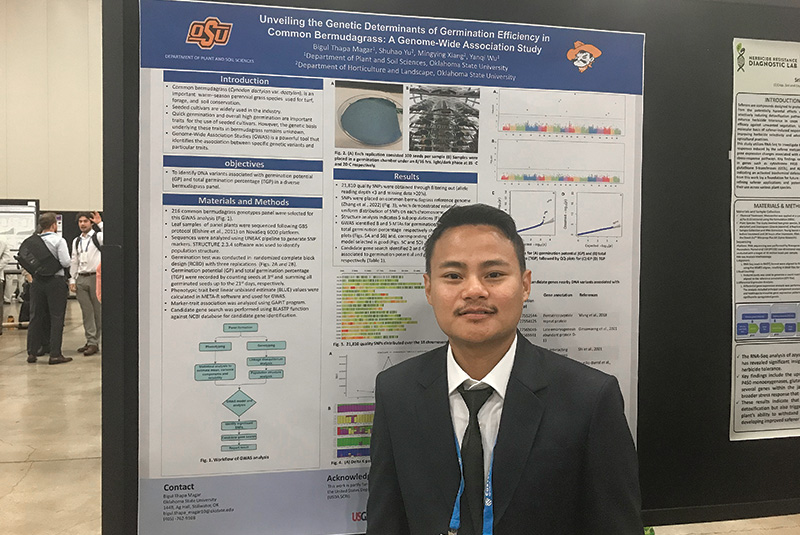
Effect of ice-encasement duration on anaerobic metabolism in annual bluegrass
Winterkill to putting green turfgrasses like annual bluegrass is a significant issue in northern regions worldwide and is expected to worsen in the future. Hypoxic conditions are consistently reported during prolonged ice-encasement studies of annual bluegrass putting greens. Therefore, we aimed to determine whether annual bluegrass is shifting to anaerobic metabolism during prolonged ice encasement. We hypothesized that hypoxic conditions would cause the accumulation of anaerobic metabolites and promote the activity of anaerobic enzymes. A two-year controlled environment study was conducted during 2022-2023 and 2023-2024 in East Lansing, Mich. Annual bluegrass plants were subjected to three durations of ice encasement (0, 40 and 60 days), and changes in percentage green cover, select anaerobic metabolite content, and the activities of alcohol dehydrogenase (ADH), pyruvate decarboxylase (PDC) and lactic acid dehydrogenase (LDH) were measured.
Results indicate that prolonged ice encasement led to slower recovery and decreased green cover, confirming the vulnerability of annual bluegrass to extended ice-encasement stress, which were associated with elevated levels of acetaldehyde, ethanol and lactic acid, alongside increased activities of PDC, ADH and LDH. Lactic acid and ethanol accumulated to higher levels than acetaldehyde across all tissues. This indicates a shift from aerobic to anaerobic respiration, which could facilitate adenosine triphosphate (ATP) production under hypoxic conditions while potentially impacting cell viability. Future research should continue to explore the mechanisms underlying anaerobic metabolite management in order to foster appropriate turfgrass management practices to reduce hypoxia conditions.
— Devendra Prasad Chalise (chalised@msu.edu) and Emily B. Merewitz, Ph.D., Michigan State University, East Lansing

Unveiling the genetic determinants of germination efficiency in common bermudagrass: A genome-wide association study
Common bermudagrass [Cynodon dactylon (L.) Pers.] is an important warm-season perennial species with great economic value for turf, forage and soil conservation and remediation. Seeded bermudagrass cultivars with a rapid germination speed and a high germination percentage are essential for establishing bermudagrass plantings efficiently and successfully, which is highly desired by the turf industry. However, genetic mechanisms of these germination traits in the taxon remain elusive. Therefore, the objective of this study was to investigate the genetic mechanism of seed-germination-related traits in common bermudagrass. Utilizing a diverse panel of 216 bermudagrass accessions and 21,810 single nucleotide polymorphism (SNPs) markers, we conducted a genome-wide association study (GWAS). The panel was phenotyped by counting germinated seeds every three days to determine the germination rate and estimate the final germination percentage over a 21-day period. After each count, germinated seeds were removed.
Substantial genetic variations were observed in the panel. Notably, a total of 13 significant associations between SNPs and traits were identified. The phenotypic variation explained by significant markers ranges from 0.68%-38.7% and 1.44%-75.19% for three-day germination rate and germination percentage at 21 days, respectively. Our research revealed valuable insights toward understanding genetic mechanisms associated with seed germination efficiency. The results of this study provided a foundation for applying marker-assisted selection (MAS) to improve overall germination efficiency in breeding seeded common bermudagrass cultivars.
— Bigul Thapa Magar (bigul.thapa_magar10@okstate.edu); Shuhao Yu, Ph.D.; Mingying Xiang, Ph.D.; and Yanqi Wu, Ph.D.; Oklahoma State University, Stillwater
Darrell J. Pehr (dpehr@gcsaa.org) is GCM’s science editor.